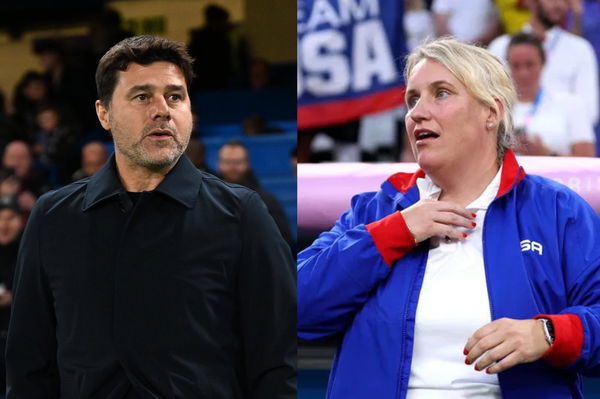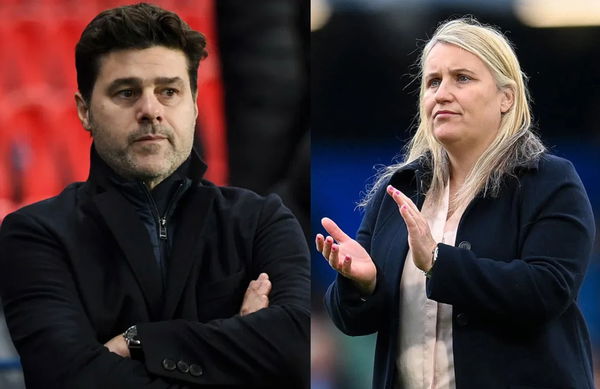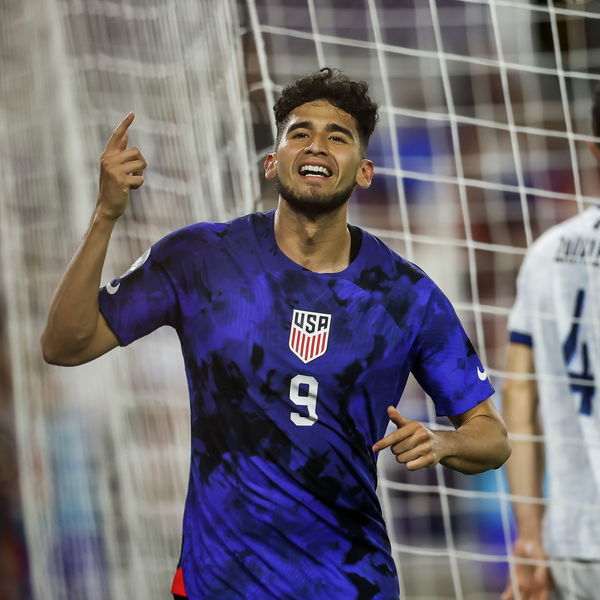
More USMNT News
Mauricio Pochettino Reveals Seeking Advice From Emma Hayes & Lionel Messi’s Boss’ Ahead of USMNT Move
New USMNT manager Mauricio Pochettino reveals how Emma Hayes and Lionel Messi's coach helped him before taking up the role.

Mauricio Pochettino Reveals How Emma Hayes’ USWNT Influenced His Decision To Join USMNT ”“ “Need To Match the Women’s”
With USMNT sealing the deal of their new coach Mauricio Pochettino, the coach now reveals the influence of Emma Hayes in his move.

“Close This Deal” ”“ USSF CEO Reveals Emma Hayes’ Influence in Mauricio Pochettino’s USMNT Signing
US Soccer CEO reveals how USWNT coach Emma Hayes helped to hire the USMNT boss Mauricio Pochettino after struggles to find a new manager.

Landon Donovan Claims USMNT Winning World Cup ‘Not a Stretch’ After Mauricio Pochettino’s Blockbuster Signing
Ahead of Mauricio Pochettino's arrival, Landon Donovan asserts that the USWNT winning the World Cup is far from unrealistic.

USSF Reveals Why Mauricio Pochettino Deal Took Longer Than Expected- “Chelsea Could Not Have Been More Positive”
US Soccer Federation breaks silence over the extended delay behind the arrival of Mauricio Pochettino as USMNT manager.

“Don’t Want to Be Nice With the Players”- Mauricio Pochettino Puts USMNT Stars on Notice With Utmost Clarity
Ahead of being appointed as USMNT boss, Mauricio Pochettino sends a clear-cut message to USMNT stars to prematurely raise the bar.

Urging USMNT Stars to Draw Inspiration From the USWNT, Mauricio Pochettino Lauds Emma Hayes- “Best Coach”
As USMNT prepares for it's new era under Mauricio Pochettino, the coach has now asked his team to get motivated by Emma Hayes' USWNT.

Trusting USMNT’s World Cup Chances, Mauricio Pochettino Lists ‘Day 1’ Goals for Christian Pulisic & U.S. Soccer Stars
Mauricio Pochettino outlines his Day 1 goals for Christian Pulisic and Co. as he expresses confidence over USMNT's World Cup chances.

“Take Risks” ”“ Christian Pulisic Demands Bold Change From Mauricio Pochettino as USMNT Boss
The sensational Mauricio Pochettino is ready to take over the reins of the USMNT as Christian Pulisic details what he needs to do.

Who Is Ken Griffin, the Billionaire Who Financed USMNT’s Hiring of Mauricio Pochettino?
Meet Ken Griffin, the billionaire who played a key role in securing the high-profile arrival of Mauricio Pochettino as the USMNT manager.

“Robbed”- USMNT Fans Roar at Referee for ‘Awful’ Call vs New Zealand
After the USMNT's opening goal against New Zealand was denied, fans erupted in frustration at the referee for the controversial decision.

Why Was Ricardo Pepi’s Goal for USMNT vs New Zealand Ruled Out? Here’s What Happened
Here’s exactly why an early goal from Ricardo Pepi for the USMNT against New Zealand was ruled out by the referee.

About USMNT
The United States Men's National Team
Soccer isn’t the first thing most Americans think of when they think “sports”— but the U.S. Men’s National Team (USMNT) has been on a journey that’s slowly, but surely, shifting that narrative. It’s a story full of gritty underdogs, unexpected wins, and a passion for the game that’s putting American soccer on the world map. Let’s dive into how far the USMNT has come, its standout players, the iconic coaches who helped shape its journey, and why this team has become so much more than just a squad on a soccer field.
Brief History- From the Early Days to Breaking Through
Believe it or not, the U.S. actually competed in the first-ever FIFA World Cup in 1930, and they didn’t just show up—they made it to the semi-finals, finishing third. It was a huge achievement, but the excitement was short-lived. The USMNT faded from the world stage for decades, missing out on the World Cup for 40 years. It wasn’t until 1990 that the team finally qualified again, scraping their way back into the tournament—and America’s soccer journey officially restarted.
When the U.S. hosted the 1994 World Cup, everything changed. Hosting on home turf sparked a national interest that couldn’t be ignored, and soon enough, Major League Soccer (MLS) launched in 1996. The world was watching, and the USMNT was beginning to make a name for itself. The golden moment came in the 2002 World Cup when they defied expectations and made it to the quarterfinals. For the first time in a long time, people started to believe: that maybe the US had a place in global soccer after all.
Managers Who Shaped the Team
No good sports story is complete without the coaches behind the scenes, and the USMNT has had its share of game-changers. Bruce Arena is a name that comes up often—he coached the squad from 1998 to 2006 and then came back for a brief stint in 2016-2017. Arena was the one who led the team to the historic quarterfinal run in 2002, making it clear that the U.S. could compete with the big guys. Arena’s confidence and American swagger on the sidelines made him a fan favorite.
Next up was Bob Bradley (2006–2011), who helped lead the U.S. to the final of the 2009 FIFA Confederations Cup, including a thrilling win over then-#1-ranked Spain. Bradley’s time saw some real growth in U.S. soccer, but the next big leap came with Jurgen Klinsmann. Klinsmann, a German soccer legend, stepped in from 2011 to 2016, bringing his European experience to the American team. Under Klinsmann, the USMNT played fast, aggressive soccer that caught the attention of fans and rivals alike. His leadership brought them to the Round of 16 in the 2014 World Cup.
Most recently, Gregg Berhalter has been in charge. Known for his analytical approach, Berhalter led the team to wins in both the 2021 Nations League and the Gold Cup. Not to forget, he was involved in a major scandal as well, accused of domestic abuse. Though he briefly left, he was reappointed in 2023, but that also ended in disappointing results. That's when Mauricio Pochettino entered the picture- to guide the USMNT toward the ultimate challenge: the 2026 World Cup, which will be hosted on home soil. Poch's stint is a chapter fans are eagerly watching as the team prepares to prove itself in front of a home crowd.
Players Who Made Their Mark
Now, you can’t talk about the USMNT without tipping your hat to the legends who’ve left their mark on the game.
- Landon Donovan is the first name on that list. Donovan became a soccer hero for Americans, known for his quick feet, creativity, and relentless drive. His famous stoppage-time goal against Algeria in the 2010 World Cup kept the U.S. in the tournament and instantly became a highlight-reel moment.
- Clint Dempsey brought a whole new level of grit to the field. Dempsey, with his fearless style and knack for finding the back of the net, tied with Donovan as the all-time leading scorer for the USMNT. His no-nonsense approach and fierce competitiveness helped define a new era of U.S. soccer.
- Tim Howard was the rock in goal for the U.S., and his 16-save performance against Belgium in the 2014 World Cup remains legendary. That match turned him into a household name as the USMNT goalkeeper who could handle even the world’s top strikers.
And now? The future of U.S. soccer seems to rest on the shoulders of players like Christian Pulisic, the face of American soccer right now. His skills and experiences with top European clubs like Chelsea and AC Milan have brought a global spotlight to the USMNT. Alongside him, talents like Weston McKennie, Tyler Adams, and Gio Reyna are showing that this generation of players isn’t just aiming to make an appearance—they’re here to compete.
Brand Deals and Big Endorsements
With the rise of players like Pulisic, the USMNT isn’t just winning games; it’s catching the eye of sponsors. Nike has been the team’s primary sponsor since 1995, making sure the team’s gear is cutting-edge and stylish. Major brands like Pepsi, Adidas, and Gatorade have also started to partner with players, seeing the potential to reach a growing audience of American soccer fans. And players like Pulisic are landing deals left and right, turning U.S. soccer into a commercial powerhouse that would have been unthinkable a few decades ago.
Public Image: From Underdogs to Contenders
For years, the USMNT had the image of being scrappy underdogs—talented but unlikely to go head-to-head with international powerhouses. But that’s changing, especially as American players succeed abroad and prove their skills on the biggest stages. Today, fans aren’t just rooting for a Cinderella story; they’re rooting for a team that wants to be a legitimate contender.
Social media has played a huge role in this transformation. Players like McKennie, Adams, and Pulisic connect directly with fans, sharing the highs and lows, whether it’s a big win or the frustrations of a tough match. The team’s public image has evolved into one that resonates with both longtime soccer fans and newcomers, especially younger fans who see themselves in these players.
With the 2026 World Cup set to be held in the U.S., there’s a fresh sense of excitement. The squad is young, ambitious, and loaded with potential. People are talking about soccer at a level that’s never been seen in the U.S., and fans are looking forward to a team that’s not just showing up to play—they’re here to take things up a notch.
The Road Ahead
The USMNT’s story is still being written, but one thing’s clear: this team is evolving fast. They’ve gone from underdogs to serious competitors, from just a team on the field to representing a movement in American sports. With a mix of seasoned talent and hungry newcomers, the 2026 World Cup will be a defining moment.
It’s an exciting time for U.S. soccer, and whether you’re a longtime fan or new to the game, the USMNT is a team to keep an eye on. Their journey shows that soccer in America isn’t just a passing trend—it’s a passion that’s here to stay. And as they get ready to play on the world’s biggest stage in 2026, there’s a sense that this is only the beginning of something truly special.
Current Roster
Head Coach: Mauricio Pochettino
Assistant Coaches:- B.J. Callaghan – Tactical analysis and game preparation
- Anthony Hudson – Midfield and defensive coordination
- Luchi Gonzalez – Attacking strategies and offensive transitions
- Goalkeeping Coach: Aron Hyde
- Fitness Coach: Steve Tashjian
Captain: Christian Pulisic
Goalkeepers:Matt Turner (Nottingham Forest, loaned to Crystal Palace)
Gaga Slonina (Chelsea, loaned to Barnsley)
Zack Steffen (Colorado Rapids)
Defenders:
Sergiño Dest (PSV Eindhoven)
Antonee Robinson (Fulham)
Miles Robinson (Fc Cincinnati)
Chris Richards (Crystal Palace)
Cameron Carter-Vickers (Celtic)
Joe Scally (Borussia Mönchengladbach)
Tim Ream (Charlotte FC)
Walker Zimmerman (Nashville SC)
Midfielders:
Weston McKennie (Juventus)
Tyler Adams (AFC Bournemouth)
Yunus Musah (AC Milan)
Gio Reyna (Borussia Dortmund)
Luca de la Torre (Celta Vigo)
Johnny Cardoso (Real Betis)
James Sands (New York City FC)
Forwards:
Christian Pulisic (AC Milan)
Tim Weah (Juventus)
Ricardo Pepi (PSV Eindhoven)
Folarin Balogun (AS Monaco)
Brenden Aaronson (Leeds United)
Jordan Pefok (Union Berlin)


